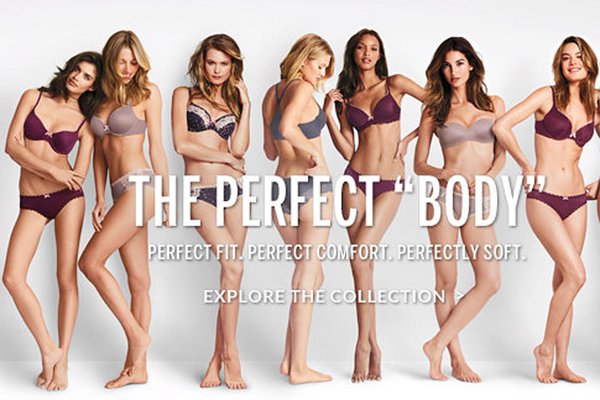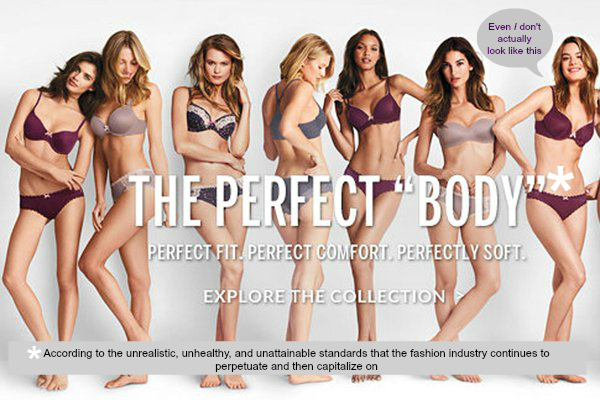1) Original Advertisement – Culture Jam Assignment:

2) The Ad and The Issue Addressed – Culture Jam Assignment:
For my Culture Jam Assignment, I chose an advertisement that was part of Victoria’s Secret’s “The Perfect “Body”” Campaign. The ad was specifically meant to market a new line of lingerie from the brand, which was called “Body” and featured a variety of different fits and styles. The specific advertisement image I choose features a line up of Victoria Secret’s models, many of which have become well known for their role as brand “angels,” wearing different bra styles while posing behind the slogan “The Perfect “Body””. In the photo, all of the women featured have very tall, slender figures, which perpetuates the idea that the perfect female body is what all of the models in the advertisement possess – one which is largely unrepresentative, and quite frankly unrealistic, for most women. The main issue with this advertisement is that it implicitly labels one body type as “perfect.” Seeing that, by definition, perfect means “having all the required or desirable elements, qualities, or characters; as good as it is possible to be,” it is only natural for consumers infer that the “perfect” body in this ad is somehow superior and is precisely what they should be striving for if they want to feel and look “as good [as possible].”
When altering/jamming this advertisement, I aim to address the issue of labeling one particular body type as “perfect.” As many studies and experts in the health field have noted, bodies vary a great deal from person-to-person. While one woman may be at her healthiest state with a figure similar to that of the women featured in this Victoria’s Secret advertisement, another woman may naturally have a curvier figure at her healthiest state. Neither of these women would have a superior body and therefore it should not be perpetuated that there is one ideal (or “perfect”) body that all women should be striving for.
3) “Jammed” Advertisement – Culture Jam Assignment

4) My “Jamming” Philosophy – Culture Jam Assignment
In editing the original Victoria’s Secret “The Perfect “Body”” Campaign advertisement, I began by adding an asterisk beside the slogan. I proceeded to edit in a disclaimer at the bottom, which elaborates on “The Perfect “Body”” with, “according to the unrealistic, unhealthy, and unattainable standards that the fashion industry continues to perpetuate and then capitalize on.” Here, I intended to point out the fashion industry is responsible for establishing much of the body-related standards that women – especially younger women – strive for. It is not that we naturally want to be stick thin or 6 feet tall. These are constructs that have been built up through advertising and marketing, which have inevitably altered the way we, as a society, define beauty. In fact, a few decades ago (around the 1930-40s), women in North America strived for curves and an hourglass figure (Yang et al, 2017). During this time, marketing executives in fashion played to this desire, used women like Marilyn Monroe (who was known for her curvier figure) to model their products in order to capitalize on the overarching trend of what society viewed as beautiful. Nowadays, fashion advertisements are boosting this impossible photo-shopped definition of beauty, which leads to women spending thousands of dollars on products, while not ever being able to actually attain the beauty standards that are plastered all over magazines, the Internet and on TV. By perpetuating these standards, fashion companies continue to cash in on women’s pursuit of the attainable – giving them more incentive to not let these standards waiver.
Another element that I added to the advertisement, which further elaborates on the intention of my editing that I discussed above, was a speech bubble above one of the models saying “Even I don’t actually look like this.” Through this, I aimed to bring up the fact that almost all fashion ads have some degree of editing. While the women in this particular advertisement are all undoubtedly beautiful, I can almost guarantee that there was some post-production editing done on them to make their looks even more unrealistic. From their airbrushed skin to their perfectly sculpted abs, it is likely that the women featured in this advertisement would seeing something different if they were to look in the mirror. Moreover, the industry further uses tactics to create this definition of beauty that is not attainable, as it allows them to capitalize on the female consumer’s continuous (and potentially never-ending) pursuit of it.
Sources:
Perfect, (n.d.). Online Etymology Dictionary, Retrieved October 18, 2017 from Dictionary.com website http://www.dictionary.com/browse/perfect
Victoria Secret Love My Body Campaign [Digital image]. (n.d.). Retrieved October 17, 2017, from http://girltalkhq.com/wp-content/uploads/2014/11/29906170001_3867172983001_thumb-newslook762034.jpg
Yang, E. L., Celestino, M., & Koeppel, K. (2017, September 29). A Look Back at Beauty Through History. Retrieved October 17, 2017, from https://www.scienceofpeople.com/2016/05/ideal-body-types-throughout-history/